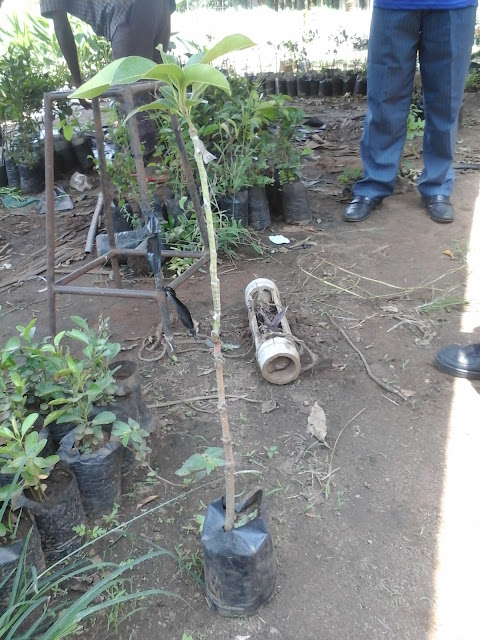How can you do grafting in your mango orchard?.
This practice is very simple to do. Follow the procedures described below, thereby at the end I hope you will be able to graft mangoes.
Mango
grafting
This refers to the process of joining the root stock of mango and the scion. But the root stock and scion should be obtained from the healthy plant. Mangoes are fruit that are native to subtropical climates. They grow best in subtropical climates with high heat and humidity. In more temperate climates, mangoes are harder to raise and typically produce less fruit. While there are several ways to plant mangoes successfully, grafting is preferred by some gardeners, grafting help the plant's ability to transmit the genetics of an existing tree to a new seedling. This helps to continue healthy growth and eliminates the chance of potentially negative genetic differences. The process of grafting a mango requires a bit of gardening skill and a plan.
This refers to the process of joining the root stock of mango and the scion. But the root stock and scion should be obtained from the healthy plant. Mangoes are fruit that are native to subtropical climates. They grow best in subtropical climates with high heat and humidity. In more temperate climates, mangoes are harder to raise and typically produce less fruit. While there are several ways to plant mangoes successfully, grafting is preferred by some gardeners, grafting help the plant's ability to transmit the genetics of an existing tree to a new seedling. This helps to continue healthy growth and eliminates the chance of potentially negative genetic differences. The process of grafting a mango requires a bit of gardening skill and a plan.
Aim
of grafting
The aim of mango grafting is to obtain a mango plant of desired characteristics such as reduced time to maturity, disease resistance, improving quality of the fruits, pest resistance, and improving productivity (profit).
The aim of mango grafting is to obtain a mango plant of desired characteristics such as reduced time to maturity, disease resistance, improving quality of the fruits, pest resistance, and improving productivity (profit).
Materials and
tools which you can use for grafting
 |
| Scions |
Procedures on how to conduct grafting of mango
- Create rootstock growth using the seeds of a successful mango tree. Water and fertilize the seed until growth occurs. Allow the new seedling stem to grow to a thickness of about 3/8 to 1 inch in diameter. If the seedling is green in color, without rot or disease, and it produces healthy leaves and buds, it will be useful as a rootstock. The proper age for rootstock is typically between 6 months and 1 year old.
- Cut the rootstock off about 4 inches above the soil using a pair of very sharp pruning shears or a grafting knife. Make the cut level, and avoid any damage to the stem below the cut. Use your grafting knife to split the remaining stem in half from the top down to about 1 inch above the surface of the soil.
- Locate a scion, or new growth shoot, on an existing mango tree. The scion should be taken from a successful tree that produces regular quality fruit and flowers. The scion should have a thickness equal to or slightly smaller than the rootstock to which it will be grafted and should have fresh buds and healthy leaves. Use your grafting knife to cut the scion from the tree, and then trim back the topmost leaves.
- Cut the open end of the 5- to 6-inch-long scion in a wedge shape. Slice away the bark along each side of the scion to create an angled point at the center. Slide the scion wedge into the slot you have cut in the rootstock so the respective cuts line up. Use your grafting tape to wrap the rootstock tightly to the scion so that all is held firmly in place.
- Place a plastic bag over the new graft from the top down, and tie it off at the bottom. The bag protects the graft from insects and pests and provides a mini-greenhouse effect by raising the temperature and moisture levels. If the graft sits in direct sunlight, cover the plastic bag with a second paper bag for a bit of shade.
- Remove the bags once the grafted tree has started growing, and remove the tape when the tree starts to produce new leaves. Water the grafted tree as you would a normal mango sapling.
 |
| A grafted mango tree |
Please listen to this audio explaining the process of grafting in mangoes
Please watch this video describing the practice of grafting in mango fruits
For more information on mango and mango grafting CLICK HERE
Thank you for your moment......!!!!




1 comment:
NGASINDA, Mwanaisha Adam (AGC/E/2013/0004)
MISANA, Stanslaus (AGC/D/2013/0029)
KINGILIWE, Emmanuel Nathanael (AGC/E/12/T/0123)
ABILAHI, Rashidi Rashidi (AGC/E/2013/0016)
MATIMBWA, Masoud A (AGC/D/2013/0033)
JOSEPHAT, Mathayo T (AGC/D/2013/0024)
HAMISI, Saidi M (AGC/D/2013/0040)
MTANGENANGE, Hussein O (AGC/D/2013/0098)
NGELENGE, Moro Sauti (AGC/E/2013/0009)
ELIBARIKI, Godbless Pallangyo (AGC/E/2013/0114)
Post a Comment